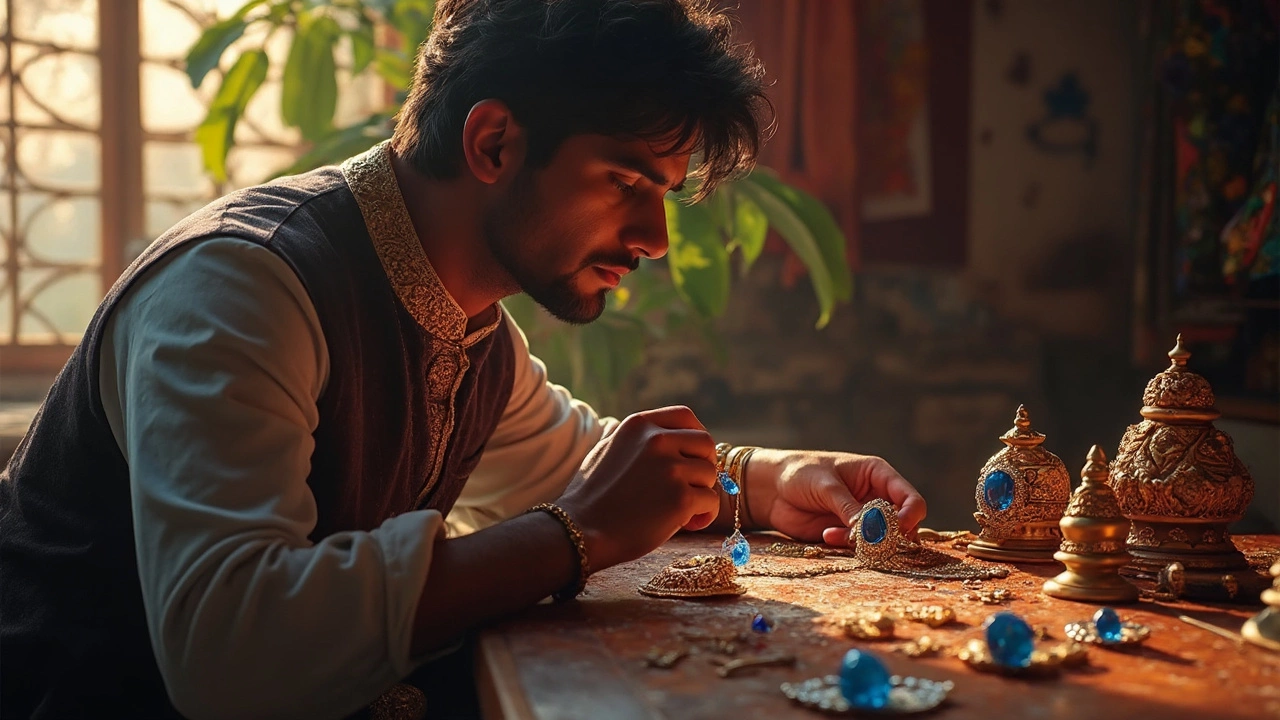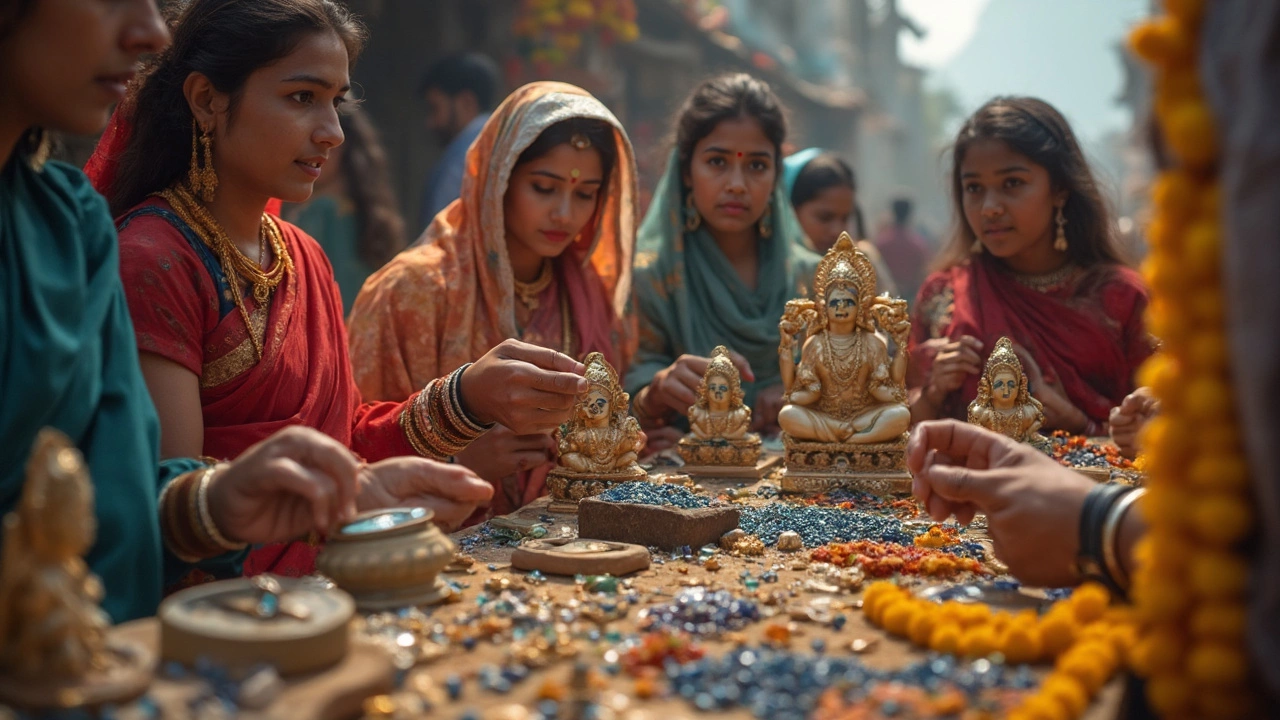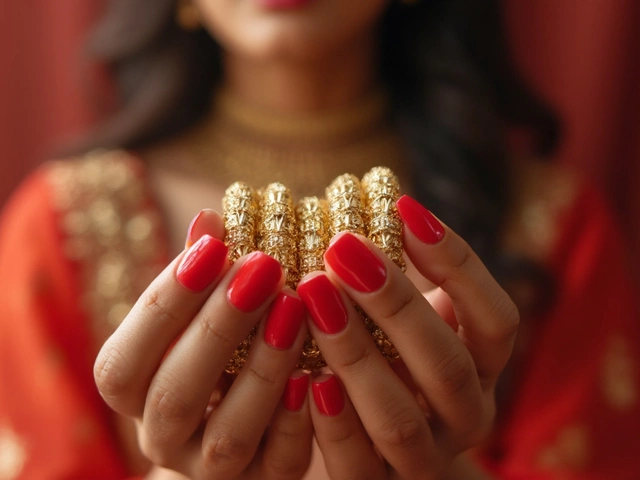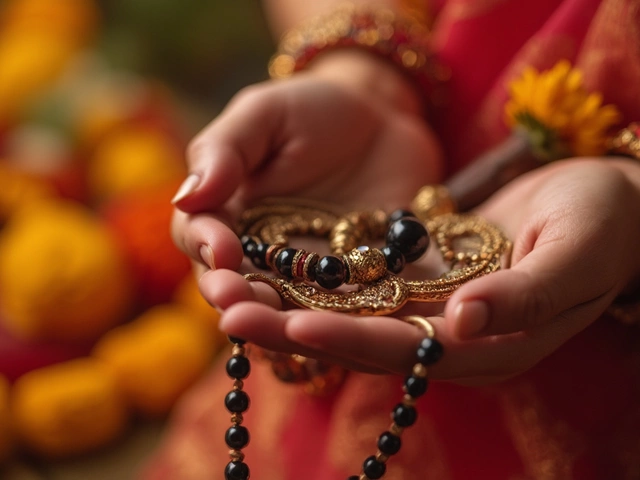
Think every blue sapphire is a Kashmir sapphire? You’d be surprised how often people mix them up, especially in the temple jewellery scene. These deep-blue gems are so hyped that dealers all over the world stamp the “Kashmir” label on anything blue and shiny. Getting the real thing is tricky, and even pros get stumped sometimes.
Kashmir sapphires have a rich history and some of the boldest, velvety blues you’ll ever see. But those fake lookalikes? They’re everywhere—online, in markets, even in fancy showrooms. If you want temple jewellery that really stands out, you need to spot the difference before dropping serious cash.
Here’s the wild part: the original Kashmir mines stopped producing stones around 1887. So, if someone’s waving around a handful of “fresh” Kashmir sapphires, alarm bells should ring. Most of what you see today is either from Sri Lanka or Madagascar, but sellers use the Kashmir hype to crank up prices.
- Why Kashmir Sapphires Are a Big Deal
- What Real Kashmir Sapphires Look Like
- Easy Tests for Spotting Fakes
- Common Tricks Dealers Use
- Keeping Your Sapphire Investment Safe
Why Kashmir Sapphires Are a Big Deal
Kashmir sapphires are legends in the gemstone world, and for good reason. They come from a tiny region in India—specifically the Zanskar range of the Himalayas—which was discovered by accident after a landslide in the late 1800s. For about a decade, miners pulled out stones with such an unreal deep blue that everyone wanted one. Then, right when demand exploded, the main source dried up. So, every real Kashmir sapphire you see is basically an antique—no new ones have entered the market for over a hundred years.
What makes these stones stand out? Color, for starters. While sapphires from other places can look inky or light, Kashmir sapphires have this unmatched, vibrant blue with a slightly misty look, which gem nerds call 'cornflower blue.' It doesn’t just glow under sunlight; it holds its color even under low light. Some even say the crystals look like they have silk inside, thanks to super fine inclusions that only genuine Kashmir stones have.
All this drama around the origin means prices shoot up, especially for temple jewellery, where status matters. The authenticity and standout look add crazy value compared to regular blue sapphires. That unique history makes them a collector’s dream and a flex in heirloom jewellery sets. If you're getting a piece with a Kashmir sapphire, you’re buying more than a stone—you’re grabbing a piece of history.
What Real Kashmir Sapphires Look Like
If we’re talking about Kashmir sapphires, you’re looking for a stone that hits you right in the eyes with a super-rich, velvety blue. These gems have a color that’s often described as “cornflower blue”—not too dark, not too light, just perfectly intense and smooth. What really sets them apart? It’s that soft, almost silky glow. Gem folks call this “velvety” because it kinda reminds you of blue velvet under soft lighting. The velvet effect comes from tiny, needle-like inclusions inside the stone — not big cracks or bubbles, but super-fine rutile silk that actually makes the stone more valuable.
Let’s get specific. Check out this quick table comparing real Kashmir sapphires, typical Sri Lankan, and Madagascar stones:
| Feature | Kashmir Sapphire | Sri Lankan Sapphire | Madagascar Sapphire |
|---|---|---|---|
| Color | Velvety, cornflower blue | Pale to mid-blue, sometimes greenish | Bright blue, often dark |
| Clarity | Silky due to rutile needles | Mostly clean, fewer inclusions | Varies; can be clear or heavily included |
| Lustre | Soft, almost glowing | Crystalline, glassy | Glassy, sometimes oily |
| Source Mines | Kashmir (India), original deposits gone by 1887 | Ratnapura and others, Sri Lanka | Ilakaka, Sakaraha, Madagascar |
The biggest giveaway is that unmistakable velvety blue—a real jaw-dropper. You’ll rarely find this shade in sapphires from anywhere else. Also, those tiny streaks inside (the rutile silk) spread the light and give that dreamy effect, but the stone never looks cloudy or lifeless.
If you spot anything labeled “Kashmir sapphire” that’s super clear, glassy, or even navy blue, step back. Authentic stones tend to have that plush, soft look. Also, most real Kashmir sapphire gems are under 5 carats because the mines haven’t produced new material in over a hundred years. Huge ones are unicorn-rare, and the price tags will knock you over.
For temple jewellery, a real Kashmir sapphire can add serious pedigree. Always check for that signature blue and soft lustre—you can spot a fake a mile away once you know what to look for.

Easy Tests for Spotting Fakes
Let’s get practical: you don’t need a fancy lab to weed out most fake Kashmir sapphires. A few simple tricks, right at home or at the shop, can help you avoid overpriced fakes. Here’s what actually works.
- Check the Color: The classic Kashmir sapphire (the real kind) shows a super-rich, velvety blue. If your stone looks almost cloudy, with a soft blue that isn’t too dark or crystal clear, you might be onto something. Super inky or light blue stones? Wrong direction.
- Look for Silk: Real Kashmir sapphires usually have needle-like inclusions known as “silk.” Hold the gem under a strong flashlight or jeweler’s loupe (10x magnification is plenty). If you see tiny, soft lines running in different directions—almost like a fabric weave—that’s a good sign. Too perfect or glassy? Be suspicious.
- Check for Heat Treatments: Most sapphires on the market are cooked (heated) to look better. Genuine old Kashmir stones rarely went through this. Ask the seller for a certificate showing “no indication of heating.” If they can’t give you one, think twice.
- Origin Report: Trusted labs like GIA or SSEF give origin reports. It should clearly say “Kashmir, India.” If it just says “Sapphire,” don’t believe the hype. No paperwork, no deal—simple as that.
- Paper Test: Place the stone on a plain white piece of paper and look from above. Kashmir sapphires hold their blue color strong, even on white, without bleeding purple or green hues. If it changes color, it’s probably not what they claim.
If you’re in a hurry, here’s a quick cheat sheet—what you should see if you’re staring at a real stone:
| Test | Real Kashmir Sapphire | Likely Fake |
|---|---|---|
| Color | Velvety blue, soft glow, not inky | Too dark, too clear, or glassy blue |
| Inclusions (Silk) | Visible under magnification, criss-cross lines | None, or too perfect |
| Heat Treatment | Usually untreated | Often treated or cooked |
| Certification | Lab origin report says “Kashmir, India” | No reputable certificate or vague info |
When it comes to Kashmir sapphire, fake stones flood the market every year. Always ask for certified proof. Remember, if the price looks way too good for the story, it probably is. Don’t let a cheap knockoff end up in your temple jewellery collection.
Common Tricks Dealers Use
When it comes to selling Kashmir sapphire, dealers have some sneaky tricks up their sleeves. Because real stones are so rare and valuable, even experienced buyers get fooled. Knowing these tricks helps you avoid paying a fortune for a stone that’s really from somewhere else—or worse, is outright fake.
Here are some classic tactics to watch out for:
- Fudging the Origin: Some sellers purposely mix up origins, passing off sapphires from Sri Lanka or Madagascar as "Kashmir." Location certificates can be forged, and even paperwork from less-reputable labs isn’t always reliable.
- Using Heat Treatments: Dealers heat-treat regular sapphires to bump up the color. These will look rich and blue, but they lose the signature velvety look of true Kashmir stones. Always ask if the stone is treated.
- Swapping in Synthetic Stones: Lab-created sapphires are almost perfect. Unscrupulous sellers blend a real Kashmir sapphire in a showcase with synthetics, then do a switcheroo at sale time. If the deal sounds too good to be true, it probably is.
- Playing with Lighting: Bright display lights hide flaws and make color pop. Dealers might show you a stone under special bulbs that make it look way better than it will in everyday light.
- Pushing Chipped or Cloudy Stones: Tiny fractures or cloudiness aren’t always obvious at first glance, but can slash the value of a gem. Dealers will gloss over these flaws or claim they are normal for antique stones.
Take a look at this breakdown of sapphire origins in the high-end market, so you know what you’re up against:
| Origin Claimed | Market Presence (%) | Average Price (per carat, USD) |
|---|---|---|
| Kashmir | Less than 1% | $10,000+ |
| Sri Lanka | 40% | $1,200 - $5,000 |
| Madagascar | 50% | $800 - $4,000 |
| Other | 9% | $200 - $2,000 |
If you ever feel rushed or pressured into a deal, walk away. Real dealers who handle genuine Kashmir sapphires are used to questions and transparency. Getting a second opinion from a trusted gem lab is always worth the time and money.

Keeping Your Sapphire Investment Safe
So you scored what seems like a real Kashmir sapphire for your temple jewellery collection. Now what? Holding onto its value isn’t just about storing it in a box and hoping for the best. Fake stones, unexpected cracks, dodgy paperwork—there are loads of risks if you’re not careful.
First thing’s first: always get an independent gem lab report. Don’t just take the dealer’s certificate at face value. Top labs, like the GIA (Gemological Institute of America) or SSEF (Swiss Gemmological Institute), will note the origin, whether it’s been treated, and even flag issues like synthetic enhancements. If you want to put the seller to the test, ask for a lab report upfront. If they avoid the topic or say it’s “not needed,” that’s a red flag you shouldn’t ignore.
Storing your sapphire correctly matters more than you’d think. These stones are tough, but scratch them against a diamond or drop them on a hard floor and you might never get the same shine back. Keep your gem in a separate pouch or lined box. Avoid storing it with other jewellery, especially diamonds—which are harder and can leave marks.
And don’t forget about insurance. High-value gems, especially ones with a proper pedigree, deserve coverage. Talk to your insurance agent about adding a scheduled personal property policy. This way, if it ever gets lost or stolen, you’re not left with nothing but regret.
- Always keep gemstone receipts and lab certificates in a safe place or digital backup.
- Re-appraise your sapphire every 3-5 years—values can rise quickly for Kashmir stones.
- If you wear your sapphire in temple jewellery, take it off before sports, heavy chores, or jumping in the pool. Chlorine can mess up the metal and sometimes the stone.
- When cleaning the gem, steer clear of any chemical cleaners. A soft cloth and mild soapy water do the job just fine.
To give you a clearer idea, here’s a snapshot of what matters for keeping a Kashmir sapphire safe and valuable:
| Tip | Why It Matters |
|---|---|
| Lab Certification | Proves authenticity and origin; boosts resale value |
| Separate Storage | Prevents scratches and damage from harder gems |
| Insurance | Covers loss, theft, or major damage |
| Proper Cleaning | Preserves color and surface quality |
| Updated Appraisal | Keeps insurance current with rising market value |
If you keep these steps in mind, your sapphire investment won’t just hold up—it might even surprise you with how much it’s worth down the line.


